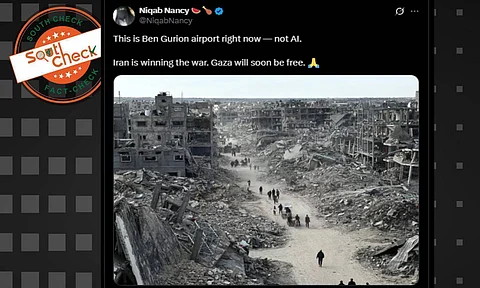

On June 15, Iran launched Operation True Promise III, firing over 150 missiles and 100 drones at Israel, killing 10 and injuring over 200. The attacks targeted military and economic sites, escalating regional tensions.
In the above context, an image is being widely shared on social media in which a ruined city can be seen. The video is shared with a caption claiming that the viral image is of Israel’s Ben Gurion airport after Iran attacked the city.
A social media user shared the video with a caption that reads, “This is Ben Gurion airport right now — not AI. Iran is winning the war. Gaza will soon be free. (sic)”
SouthCheck found that the claim is false. The viral image is old and is of Gaza.
On a Google reverse image search, we found that the same image was shared by a website, Diakonia.se on January 23. The image was shared with a story which suggests that the viral image is of Gaza. The report associated with the image suggested that on January 19, a ceasefire halted over 15 months of Gaza‑Israel hostilities. Both sides and third‑party states must still uphold legal obligations—ensuring humanitarian access, detainee rights, accountability for violations and reconstruction.
We further found that a similar image was also shared by Reuters with a caption that reads, “Palestinians walk past the rubble of houses and buildings destroyed during the war, following a ceasefire between Israel and Hamas, in Rafah in the southern Gaza Strip, January 20.”
We compared both the images and found them to be similar. We can find the remnants of the same building on right sides and the same iron structure can be seen on the left side of the images. Hence, we can ascertain that both images were of the same location.
According to a report published on a Canadian website, The Globe and Mail, on January 20, on the second day of a ceasefire, Palestinians began searching for thousands buried under Gaza’s rubble after 15 months of war. Over 47,000 have died, and rebuilding may take decades. Aid is flowing in, but devastation remains vast.
Hence, we can ascertain that the viral claim is false.